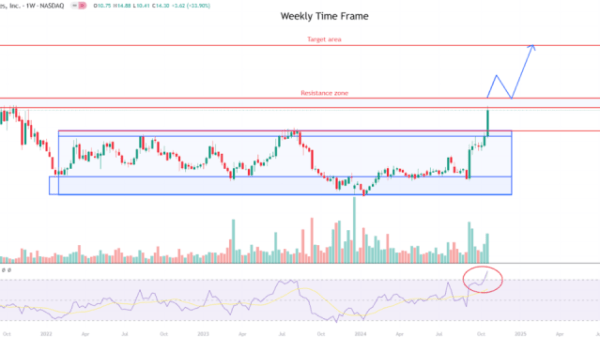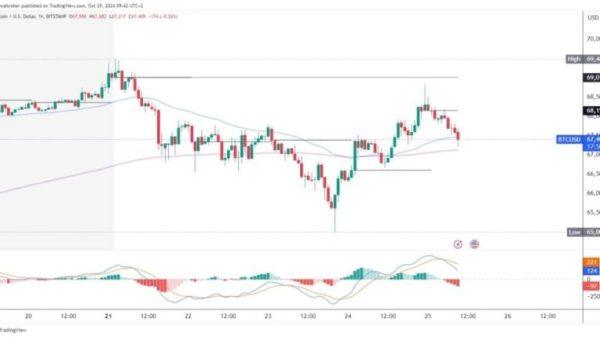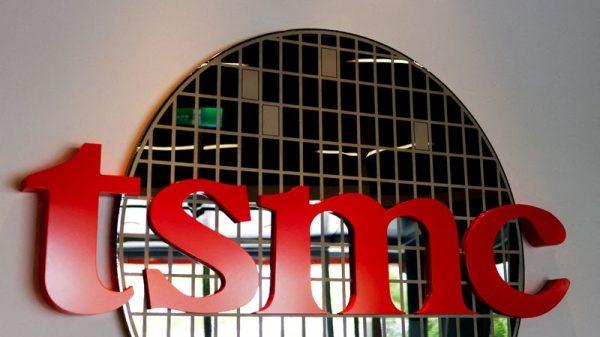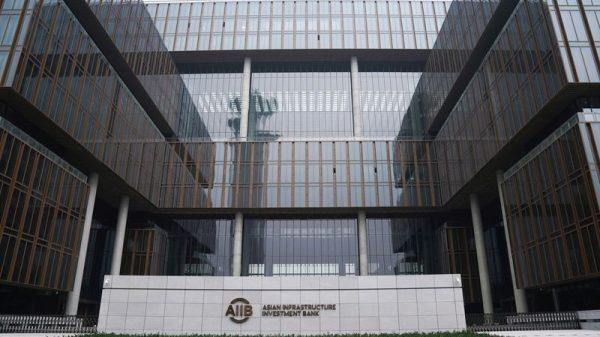Eurofins Scientific SE (ERF.PA), a global leader in bio-analytical testing, has reported a mixed performance in the third quarter of 2024 during its Nine-Month 2024 Trading Update. CEO Dr. Gilles Martin outlined the company’s strategic advancements and addressed challenges in specific sectors. Despite a decline in Q3 growth, particularly in North America and a 15% drop in agroscience demand, the company remains on track to meet its 2027 objectives. Significant investments in IT infrastructure are expected to improve data protection and service quality, especially in clinical diagnostics. The company is optimistic about future growth in the biopharma sector, highlighting a new 10-year contract set to begin in the second half of 2025. Eurofins is also actively exploring mergers and acquisitions (M&A) and share buyback opportunities.
Key Takeaways
Eurofins is building a hub-and-spoke lab network, expected to complete by 2027.
Investments in IT infrastructure aim to enhance data protection and service quality.
Q3 growth declined due to weaker performance in North America and agroscience.
The company is optimistic about biopharma growth, with a new 10-year contract starting H2 2025.
Currency fluctuations may impact revenue projections, but margins remain strong.
Regulatory changes to the French tax rate are unlikely to affect Eurofins, based in Luxembourg.
Pricing cuts in French clinical diagnostics could lead to an 8% revenue drop, but volume growth may compensate.
A financial audit countered short seller claims, supporting Eurofins’ financial stability.
Cost management is ongoing, with a focus on transparency and investor engagement.
Company Outlook
Eurofins expects to meet its 2027 objectives despite current uncertainties.
The company’s biopharma sector is anticipated to recover in 2024 with good funding and potential restart of large studies.
Eurofins remains cautiously optimistic about the agroscience segment’s visibility.
Bearish Highlights
The agroscience segment experienced a 15% demand decrease.
Organic growth in biopharma is below target due to clinical trial delays.
The company noted a slowdown in the cadence of new start-ups, particularly in Asia.
Bullish Highlights
Food and environment testing segments exceeded objectives.
The company is pursuing M&A opportunities and share buybacks to enhance shareholder value.
Eurofins anticipates improved profitability and cash flow in the future.
Misses
Eurofins acknowledged weaknesses in Q3 and a cautious outlook for 2025.
The company has experienced no new high-intensity start-ups in the recent quarter.
Q&A Highlights
Dr. Martin clarified that clinical trials are expected to pick up in H2 2024.
The EY forensic report is considered thorough, covering over 93% of cash and cash equivalents.
Eurofins’ exposure in China is limited, with less than 2% of revenues from the region.
Eurofins Scientific SE continues to navigate a complex global market with a strategic focus on long-term growth and operational efficiency. The company’s resilience in the face of sector-specific challenges and its commitment to stakeholder engagement position it to potentially capitalize on future opportunities as it moves towards its 2027 goals.
Full transcript – None (ERFSF) Q3 2024:
Operator: Ladies and gentlemen, welcome, and thank you for joining Eurofins’ Nine-Month 2024 Trading Update. Please note that this call is being recorded and will later be available for replay on the Eurofins Investor Relations website. Throughout today’s presentation, all participants will be in a listen-only mode. The presentation will be followed by a question-and-answer session. [Operator Instructions] During this call, Eurofins’ management may make forward-looking statements, including, but not limited to, statements with respect to outlook and the related assumptions. Management will also discuss alternative performance measures such as organic growth and EBITDA, which are defined in the footnotes of our press releases. Actual results may differ materially from objectives discussed. Risks and uncertainties that may affect Eurofins future results include, but are not limited to, those described in the Risk Factors section of the most recent Eurofins annual and half year reports. Please also read the disclaimer on Page 2 of this presentation, subject to which this call and the Q&A session are made. I would now like to turn the conference over to Dr. Gille Martin, Eurofins CEO. Please go ahead.
Dr. Gilles Martin: Hello, everybody, and thank you for joining our quarterly call. We don’t have a lot of material to discuss, but we have a short presentation that you can look at. So, I’ll start on Page 3, and Laurent and I will be available to answer questions. So, we’ve continued to make good progress in Q3 on all our initiatives, building our hub-and-spoke lab network. As we wrote, we should be done. We should complete this activity by 2027. We continue to invest massively in our IT infrastructure, both in terms of IT infrastructure or network where we are rebuilding a very resilient and compartmented IT structure to be more protected from potential cyberattack to protect our data and our clients’ data better and in developing and deploying our proprietary suite of IT solutions to be fully digital and fully integrated in what we do. On that level, we start to have a lot of data because we have still some business lines like clinical diagnostics where we have not done that. And we see that the spend intensity in IT in those business lines, which typically represent the industry, a big patchwork of IT solutions is up to twice as high as what we have in the business lines where we have done that already like, for example, biopharma product testing. So those investments in digitalization, not only will they bring much better quality of service performance, ability to detect potential errors and speed of service to clients, but they’re also on the long term when they are finalized very cost effective. So, this is something — those are the areas, less visible, of course, than our buildings and our labs where we continue to deploy significant amount of capital and also operating costs because it’s also a lot of our users who are designing and testing those solutions. So operationally, we continue to make progress. You have seen that our growth in Q3 was a bit less. Maybe I can give a bit of color on that. This is mainly coming, as you can [Technical Difficulty] see by area of activity. Of course, our growth is softer in North America because biopharma is a larger percentage of our activities in North America. This is partly due to some segments of biopharma, the things we have put into this biopharma activity. The biopharma product testing is actually doing quite well. It’s mostly working for larger companies and products that are later in their development. The BPT area is still close to mid-single digits. Okay. In the best years, it was close to double digits, but still, it’s still doing fine. The areas of life, so food and environment testing, as you see, are growing above our objective, so is consumer testing, diagnostic services and products are growing a bit like their historic growth around 4%. And within biopharma, the areas where we’ve seen some real softness in agroscience, the whole industry is very challenged. After a number of years of challenging situation in the market for our clients and uncertainty about the regulations for getting new pesticides, agrochemicals approved, there is some contraction in demand. This was down more than 10% in — almost 15% in Q3. Of course, it will plateau, it will bottom up. So, we’re optimistic that next year will we won’t see the same type of decrease, but it is in one quarter, quite significant. Another area that maybe we could have lagged a bit more, to that in biopharma, we have a number of laboratories or central lab, for example, working for clinical trials of new drugs doing the testing required for clinical trials. And what we’ve — that can be a bit lumpy because it can be very large studies. We’ve had a client that had a big success with one study and had to — and could cancel a follow-on study because FDA didn’t require it. So that was unexpected and a lot of work stopped at the end of Q2 for that client. Then, we’ve got other clients, which studies completed. We’ve signed a very large 10-year contract with them that will start in the second half of next year. So, we’ve got a little bit of a lull in the clinical part of our business. Clinical part of biopharma is less. Central lab part is much less than biopharma product testing. But when you have an activity, big studies that stop, you can be also minus more than 15% that has an impact on the quarter. We see that as absolutely transient. And actually, when that picks up, it can really boost the other way around. That’s why we are confident on our average growth for the five years and we haven’t changed that. But on one quarter, it is visible. Otherwise, all of our activities are doing fairly well. We have put a bridge. We’re continuing our M&A programs. We’ve been fortunate to find quite a lot of bolt-on deals at quite acceptable multiples. So, our spend on M&A compared to the revenues we are buying for the full year might be — and potentially for what’s coming for next year might [Technical Difficulty] that as freight some money for us to buy back our shares that we would have otherwise allocated to M&A. As you can all see, I think our share is the biggest opportunity in the TIC market at the moment. So, we are investing in buying back our shares at the moment and we’ll step that up, if things continue. That’s because we’re saving on M&A. On our CapEx program, we are moving as planned. Our reorganization, we are moving as planned. It does cost us a lot of money to build this hub-and-spoke network, but it is also a finite investment in time, and every year, we are getting closer to being done on that. On Page 5, we’ve discussed a bit our objectives. The profitability is continuing to be above plan and has continued to be above plan in Q3 in terms of margin. The overall revenues for the year will be a bit less than what we anticipated. We have a hit from currency, a significant hit from currency that, of course, we don’t know what the currencies will do in the next two months. But assuming there are not some very significant changes, they will be below the target, so that will impact the top-line and translationally, of course, profits, but our margins are higher than that. And we have a bit of a gap on organic growth in biopharma that I think will continue in Q4 and we thought we should flag it now. So, that’s our objectives. We think we will deliver on our cash flow and we’re also confirming our objectives for 2027. As we said, we believe, this situation in biopharma is very transient. Our clients are positive. We have won a very large preferred partnership agreement with a large biopharma that is going to start also next year, and we believe it could add material volumes. So, we are positive over the next couple of years, and we think we can achieve our objective for 2027. So, that’s it for our objective and for the introduction. I think we can open the microphone to Q&A, now please, operator.
Operator: [Operator Instructions] Our first question is coming from Himanshu Agarwal with Bank of America. Your line is live.
Himanshu Agarwal: My first question is on biopharma, which, as you mentioned, sequentially deteriorated quite substantially into Q3. Can you give us some color on the trends, especially in agroscience exiting Q3? Are you seeing some improvement, stabilization? And also, how much is it as part of the group because it should be quite significant to weigh on the organic growth of the overall biopharma division? So that’s the first one.
Dr. Gilles Martin: Thank you very much. Well, agroscience is not much. I think we put somewhere in the press release, it’s about 2% of the overall growth size of the group. The other part that’s also affected, as I mentioned, is the central lab and the — which is also a few percent of the group. But you’re talking a very significant drop more than double digits. The other thing, if you look at it, is biopharma as a whole, so BPT is also not at our objective of 6.5% is a more slightly below double digit. So that has an impact. We’ve got discovery that we had flagged before, the earlier part. It’s also a small activity for us, a couple of percent of our group, but discovery is not going down now, but it’s more flattish, and that’s also a gap to growth. It’s not that we’re talking that our overall revenues are going down, and they are actually growing. We’ve had continued growth in the first nine months of the year, but it’s growing less than before. So, if you have some negative that impact the rate of growth.
Himanshu Agarwal: And also on the 2025, it seems like the improvement that we expect in biopharma is going to be more back half weighted. Is there any risk of delays in terms of starting these clinical trial projects? Because I think a lot of the improvement in biopharma is potentially dependent on those. So, what is the confidence level on those starting into second half?
Dr. Gilles Martin: Well, it’s not only that. We think our overall biopharma will improve next year. we flagged the second half for those specific clinical trials. But overall, our teams for biopharma are positive. Our biopharma product testing, teams are fairly positive for next year. I haven’t seen the final budget nor discussed all the budgets with them for next year. But they see some — a lot of things have bottomed up out also in discovery, very good biotech funding. The cherry on the cake in the second half might be that indeed, those large studies do restart on top of the overall recovery of biopharma that we still see coming next year. Of course, it’s very hard to time it exactly by one quarter. It’s a whole industry, but we are — our leaders are positive about the development there. And you’ve asked for agroscience. The only place where we have no visibility, the agroscience about when this will recover. This is linked to a number of factors that are really not — that are hard to see, both regulatory and overall, how the industry is doing. And that’s why we have flagged it that both the seed area and the agro area might be challenged for a while or not, but it could well be challenged for a while. It’s not a major part of our group, as I mentioned, 2%, but still there on that small part, we don’t have much visibility.
Himanshu Agarwal: And just last question, housekeeping. On the — can you just talk about the potential impact of changes in French tax rate this year and potentially next year?
Dr. Gilles Martin: Well, we don’t think we’ll be affected by that. First of all, Eurofins is a Luxembourg-based company. It’s not a French company, although we are listed in Paris. And we believe our size — the size of our activities in France as defined. I don’t believe the laws are passed yet, but with the — how the laws look like, it doesn’t look like we will be affected. Our activities would be below the threshold.
Operator: Our next question is coming from Annelies Vermeulen with Morgan Stanley. Your line is live.
Annelies Vermeulen: Gilles and Laurent, I have two questions, please. So firstly, just taking back to 2025, your comments in the press release. The commentary reads quite negatively or cautiously at least particularly for the first half of 2025. Could you perhaps elaborate on what you expect to see in each of your end markets, particularly in the first half of the year. And based on what you can see today, do you expect to be able to deliver annual average organic growth in 2025? Or is that contingent on that biopharma activity coming back in the second half? And then secondly, on the SGS Crop Science acquisition, in the statement, you’ve you filed an arbitration against SGS in August. Could you remind me exactly what that involves and how long does that process usually take? I’m just wondering when we might see an update on that process.
Dr. Gilles Martin: Yes, for next year, we have no reason to think that we wouldn’t achieve the organic growth that we have in our objectives, and if it was otherwise would have said it. We flagged a couple of things. Maybe it sounds negative because we want to be transparent. At agroscience, we don’t have visibility, but it’s a small business. And the fact that we have those clinical activities that where we are sure actually because we’ve signed contracts that they would restart next year. But the rest of biopharma is doing well. We think the funding of the biopharma is good, has recovered a lot for biotech. Our clients have done a lot of soul-searching into which programs will continue or not, but this trend is finishing. We have an Investor Day tomorrow in London. So, the Head of Biopharma, Global Biopharma Business line, Tim, will talk about it, can give you a lot more color than I can. And again, we have not set our objectives for next year, so I can’t be too specific about it. But overall, what we said in the press release is we are positive about the overall growth outlook of our business. For the SGS Crop Science, yes, we feel that we have signed a deal and the deal should have completed, and we feel the other party did not do everything they should have done to make the deal complete. And therefore, we have filed for arbitration and those processes take months. I mean normally, arbitration is faster than court cases, but it still can take a couple of years.
Annelies Vermeulen: Okay. Thank you.
Dr. Gilles Martin: But it’s a 45 million business. It’s not a huge business. So, it’s not like — it’s not going to change anything on the bigger picture principle. If the deal is signed, we think it should complete.
Operator: Our next question is coming from Suhasini Varanasi with Goldman Sachs. Your line is live.
Suhasini Varanasi: Just a couple for me, please. The pricing cuts in clinical diagnostics in France. Can you please clarify what is the extent of the cuts and scale of revenues it applies to? Second one is on the financial order. It is good to see some of the results that got published today. Is there any other color that you would like to flag over a number what’s there in the press release?
Dr. Gilles Martin: Yes, those pricing cuts, the effect only our routine business because if they were test specifics or specialty business is almost not affected by those. The pricing costs are something like 8% on 300 million of revenues. That’s the impact. Of course, we will have volume growth next year. And I guess that pricing cut supersedes any other cuts that they would have been normally, there are costs of 3%, 4% per year. So, it’s a bit higher than usual, but it’s not like earth shattering. It doesn’t also affect our whole business. But we thought we should flag it. So, the investors know the things that are going on. I mean, some of you have seen it maybe others didn’t. On the financial audit, yes, we were pleased. We’ve been attacked totally unfairly by short sellers. Of course, we all know and professional investors know why those people do that. They do that for their own interest and to make money out of it. They were certainly ill-informed and ill-advised because we’ve been able to reshoot all of their arguments, all of their claims, all anything they insinuated that we’ve been able to go back and improve it. It is a bit silly that we have had to ask external auditors to audit our cash situation that had already been audited by Pricewaterhouse — by Deloitte, sorry. And prior to Deloitte, we had for years Pricewaterhouse. So, it’s a bit silly that we have to spend money to do that, but the report is for all to see. It’s very easy for someone to say, okay, I’m sharing a journalistic opinion and without any burden of proof or any consequences, they can claim any non-sense or any fallacy or anything they want to claim. Of course, anything we put in a press release, we have to prove, we have to justify, we have to document, and we have to have to engage external advisers and things like that. The value of what we put is, of course, it has to be right because otherwise we’re liable for what we write. It’s not — it’s really two different level of certainty of reliability on both sides. I’m surprised that investors get fooled so easily by those short sellers’ report, but unfortunately that’s what it is. But I think we’ve done everything we could to cover, to basically respond. We know that those related parties and situation that we’ve had historically, they of course create an opportunity for trying to make companies management look bad. And that opportunity we want to remove, and we will work on that. We are working [Technical Difficulty] regulations and all those buildings to potentially get them bought by Eurofins, if Eurofins shareholders so wish because that’s an open flank. Even though we are sure we didn’t do anything bad there. And the Company has made all efforts possible to make sure everything was at home lengths. We cannot prevent people from claiming. It is not the case, if they don’t have to prove anything. So, we will also work to get that behind us. We’ve had on that occasion, extensive discussions with shareholders, and we heard listen to anything that could bother them. And we’re trying to address anything that comes up. There was questions about our Board. Maybe we’ll add some one member of our Board that is also independent to have assure people in each of the committees or for overlaps between the committees, that’s something we heard we’re going to work on. And we’re going to continue to improve anything, the rating agencies, agencies have significantly improved the ratings of Eurofins. We’ll continue to do whatever makes sense on that level. We’re improving expansion ration report. So, we’re doing a number of things. So, we’ve really always been listening to investors and doing things that make sense. But that provided the silver lining. It provided another occasion to communicate exchange with our core investors and listen to what’s important for them, and we’re making progress on those things, too. So, I think that financial audit closes the door and put a little on those totally unfounded claims, and we can move on and focus on our business, which is improving. And the main thing is I’m very pleased about the financial development in the Company, our profits and our cash flow are really growing. We are coming into a phase now where we will reap the benefits of all those investments. So, the next few years look very positive. And yes, so we’ll generate cash. And if the market doesn’t recognize it, we’ll just buy back our shares.
Suhasini Varanasi: Just a follow-up, please. I think in your press release, you had indicated that you might put to the vote to shareholders about buying back the sites owned by related parties. Is there any timing on that vote, would it be next year, early next year, mid next year?
Dr. Gilles Martin: Yes. If we can get everything done by then, if we can get all the valuation done and everything, we’ll try to put that at least for part of the buildings on the agenda of the next general assembly. I don’t want to do a special general assembly just for that, but that will be the likely timing.
Suhasini Varanasi: Thank you.
Dr. Gilles Martin: And same thing if we’re going to add a Board member, that would be the timing where we would probably do that once a year, we propose to the shareholders the reviews of the Board membership.
Operator: Our next question is coming from Tom Burlton with BNP Paribas (OTC:BNPQY). Your line is live.
Tom Burlton: I’ve got a few. I’ll just start on just biopharma just on the cost side there, I guess, because on the H1 call, you’d referenced group’s response on the cost side to some of the lower growth you’ve seen kind of elsewhere in your European business. And where you’ve been carrying a bit too much staff for activity, you adjusted the cost base. You suggested that if things didn’t turn around in biopharma, you might do the same there. So, I’m just wondering with the weakness you kind of observed in Q3, the softer outlook you talked about the 2025 and some of the recovery expectations being pushed into the second half of next year. How is that doing around cost evolving? Or have you, in fact, already started taking action on the cost base there and maybe that’s why you’re able to give a better message on the margin and profitability, and to trying to understand just margin protection versus maintaining deficient capacity there for when that market eventually recovers? Then on start-ups, your guidance notes mentioned you expect to continue the high intensity of start-ups, but I think, and correct me if I’m wrong, there weren’t any startup to launch this quarter. I know there was some blood collection points, but that marks, I think in the first quarter, in several years or we’ve had no start-ups. So, I’m just wondering how we should think about the cadence and sort of quarterly and annual sort of planning of start-ups? Any reason why you didn’t open any up this quarter. Is it just a timing to, I guess, based on response to activity? Or was that always part of the plan? And then finally, just on the — one more on the EY forensic report a comment that’s come up with a few investors today is regarding the state within the report around limits of the report. And it references that some of the information provided by the group was on occasions incomplete. I appreciate some of that might just be a standard sort of disclaimer language, but maybe you could just give some comments on why that — if that’s the case, why that might have been, as it suggests some of the conclusions could have been different if the information has been more complete? So, any reassurances or kind of details you can give there would be helpful.
Dr. Gilles Martin: Yes, while we cannot decide on when our clients start some new programs and so on, we can control our costs. So, costs, of course, our teams are managing their cost. And yes, in agroscience, they were a bit slow in responding and managing their cost, but they are doing so now. And in other areas, of course, they are managing their costs. It’s faster to manage costs in America than it is in Europe, especially if you’re talking about personnel costs, but this is being done. And if there is — these things don’t develop as fast as we think they will, of course, they will be adjusted further. You’re right. On start-ups, we have a plan to open a number of BCPs, blood connection points, which are relatively low-cost start-ups. We are now, in many areas, we’ve done the start-ups we needed to do. We are still planning a number of startups, for example, in North America for food testing labs, microbiology labs, water testing labs, but they are — we didn’t do one this quarter. I would say, probably the cadence of start-ups will slow down because also in Asia, we are waiting to see in China. We’re a bit more cautious about China. So, we are waiting for the start-ups that we’ve made to come to hit the targets of profitability that we’ve set. I don’t have the budget for next year. So, it’s hard for me to answer specifically, but I would say, yes, the trend in volume of start-ups, number of start-ups over the next two or three years will go down. Anyway, we also are targeting a lower impact in terms of percent of the EBITDA that is affected with the start-ups. But we do have a plan to open quite a number of BCPs to complete certain regions where we thought M&A is too expensive. And for the forensics, yes, this is standard language, but I will let Laurent answer. I think he has had extensive discussions with why on this. So, he will tell you why they write that.
Laurent Lebras: Yes, indeed. This is a standard disclaimer that the forensic auditors always use. I mean on the contrary, I mean, EY has been performing a very thorough investigation with the coverage, which is reaching more than 93% of the cash and cash equivalents, which is not often seen in such exercises. No, this is just standard. Overall, as you can see, the fundings were very limited and all immaterial. So, this was very reassuring report for all the people who had the doubt maybe [Technical Difficulty] in terms of cash management or accounting and the cash position in the balance sheet of Eurofins at the end of last year. No, Ernst & Young would not sign the report. They are the leading auditor for [indiscernible] in France.
Operator: Our next question is coming from Allen Wells with Jefferies. Your line is live.
Allen Wells: Gilles and Laurent. A couple for me, please. Firstly, I just wanted to follow up on a question from earlier. I think it was [indiscernible] was just kind of digging into the shape and timing of the growth slowdown, particularly in relation to see the pharma and agro and diagnostics business. Obviously, it looks like it slowed materially in 3Q. So could you maybe just confirm — I’m not sure it was confirmed if the exit rates were actually weaker. I’m just trying to work out as we think about the fourth quarter when you see 3Q drop to what looks like a 3% underlying organic growth number, if I strip out the working day impact. Is that the trough or can 4Q actually drop lower based on directionally? That’s the first question. And then secondly, just on diagnostics. You mentioned the price cut in September needs to be absorbed. Given that quite large magnitude of price cuts, how long do you expect it to take for that run rate to be absorbed, so you get back to the mid- to low single-digit growth number within that business?
Dr. Gilles Martin: No, we’ve seen the forecast for Q4 of our leaders, and they don’t — they’re not planning to further slowdown in Q4, as we can tell. We’re not negative on the evolution in Q4. So, that’s for your first question. I understand it’s 24 million, so that’s 6 million per quarter. That’s the impact on Q4 of this activity in France. And normally, we end up compensating with volume about 4% per annum. So that’s about a two-year impact in terms of volume to compensate from organic growth without the BCPs that we’re opening. Of course, the BCP that we’re opening, they had a lot more growth, so it’s going to be compensated a lot faster.
Operator: Our next question is coming from Arthur Truslove with Citi. Your line is live.
Arthur Truslove: Arthur from Citi. My first question was just on your full year margin guidance. So, you’ve obviously at the midpoint, the EBITDA guide, you’re talking about a margin of 22.1%, which if I’m not wrong, is the same as in H1. My understanding was that normally H2 exceeds H1 by sort of 100 basis points or so. So, I was just wondering if you were being a little bit conservative there. The second question I had was in respect of a bit of staff turnover. So, I saw that Natalia Shuman, who we met at the CMD last year and I think the year before as well, seems to have left the Company. She is obviously [indiscernible] involved in biopharma. I was just wondering, if you have any comment on that? And then my final question was on the consumer and technology side, you saw an acceleration of organic growth in Q3. And I just wondered what drove that.
Dr. Gilles Martin: Yes, H2 is normally better than H1, and we think it will be this year. There’s a lot of rounded numbers. And first of all, when we say close to 7 billion, it doesn’t mean it’s going to be exactly 7 billion, that’s one side, and we’re being — yes, we try to be conservative, but we did more to flag that the margin will be higher than it was initially planned. Anyway, all of that is a good point because the market is valuing us as if we had only a 15% EBITDA margin. So frankly, that’s talking about things two comma after the digit or one comma after the digit seems a bit irrelevant in the current context. But I appreciate you are doing your work precisely. But indeed, we are generally conservative. Yes, Natalia, I can’t say too much, but she had to go back. She lived previously in the U.S., and she had to go back to the U.S. for a personal reason, and our scope was biopharma Europe primarily. So that couldn’t be continued, unfortunately. Consumer and tech, it did well in Q3. It’s a relatively small business. So, it’s more Asia-focused, Asia biased, and we had some tougher comps before. So, it is a bit of a recovery there. I wouldn’t read too much. Generally, I wouldn’t read too much on one quarter. I said that repeatedly. But I think the overall trend in what we do in all the activities are good on the midterm. That’s why we give a growth objective, which is an average over five years, which we think is achievable. And of course, every quarter, there’s not a lot of news, and there’s not a lot to talk about. So, we focus on small differences, but they are not always meaningful in terms of long-term value.
Operator: Our final question today will come from Shubhangi Gupta with HSBC. Your line is live.
Shubhangi Gupta: My first question is, again, on the biopharma business. If I look at commentary from most life science and biotech companies, they have started to see improvements in biotech funding, book-to-bill ratios and orders, et cetera. However, if you expect a recovery in 2025. So, is it down to a few large customers because as I’m seeing the end market has started to show signs of improvement? And second question, just on China. Do you expect any impact from the China stimulus program or the volume-based procurement that has started impacting the diagnostics business in China?
Dr. Gilles Martin: Thank you very much for your question. Yes, I think something has been really misunderstood in our press release, we’re not saying that biopharma as a whole, will pick up in H2. We think biopharma is picking up. And as I mentioned, our BPT business is actually doing relatively well. It’s already at a mid-single-digit growth. But what we mentioned specifically for H2 were clinical trials, so studies, large central laboratory testing programs, which we will — we have known contracts that will start in the second half of next year. So, that’s what we wanted to say. But the clinical part in Eurofins is sub-5% of our total business. So, it’s not — whereas BPT is maybe 15% of our total business or more. I don’t have the exact numbers in my head right now. So, we’re not saying — we think our whole biopharma will only start growing faster in the second half of next year. What we said is those clinical trial activities, we know they will pick up in the second half of next year. China is stimulus. It’s hard to say for us what the impact direct or indirect will be or diagnostics, we’re small in China. We are — China is a little so less than 2% from our revenues. We are in a business where scale matters. And as a foreign player, it’s difficult to have scale on purely local Chinese market. It’s quite ambitious, and to think that a foreign company can dominate a local market in China. So, we are not trying that. We are working — mostly focusing in our areas in international trade. So, testing products that go in or out of China, either for Chinese importers or for importers of product from China.
Operator: All right. This is all the time we have for today’s question-and-answer session. We would like to turn the conference back over to Dr. Gilles Martin for any closing remarks.
Dr. Gilles Martin: All right. Well, thank you very much to all of you for joining the call. We are looking forward to meeting many of you in London tomorrow and in New York in a couple of weeks for those of you who are from North America. As I mentioned in introduction, as we wrote in our press release, we think the outlook for all of our businesses is very good. We see our profitability continuing to improve, our cash flow continuing to improve, and cash flow would improve not only because profitability improved, but also because we — little by little, we will be done with all those programs that cost a lot of money, either building our hub-and-spoke network or big sites, or developing the new generation of digital solutions to run our business. So, we’re doing a lot. We’re spending a lot. We’re doing it on many activities or many continents, but this is making progress. And we are still convinced we are building a very strong franchise in very attractive markets. And yes, BPT, some biopharma activities and agroscience were soft in Q3. We think, overall, in the long term, they are needed and they will certainly pick up. So, thank you very much for your support and looking forward to meeting you in person soon. Goodbye.
Operator: Thank you, ladies and gentlemen. This does conclude today’s call. You may disconnect your lines at this time, and have a wonderful day. And we thank you for your participation.
This article was generated with the support of AI and reviewed by an editor. For more information see our T&C.



































